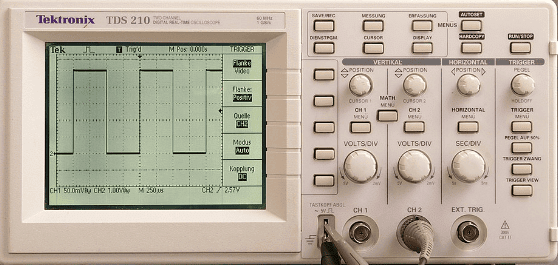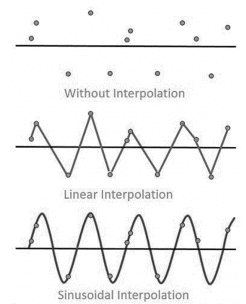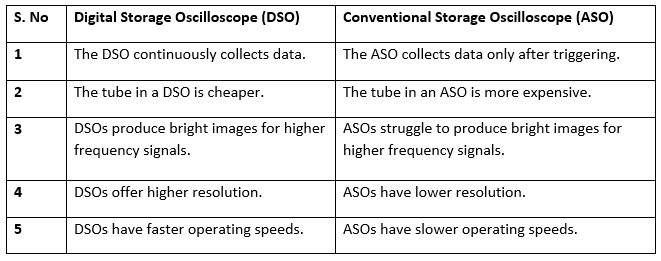Digital Storage Oscilloscope | Electrical and Electronic Measurements - Electrical Engineering (EE) PDF Download
Introduction: Digital Storage Oscilloscope (DSO)
A Digital Storage Oscilloscope (DSO) is a specialized type of storage oscilloscope that can store an input signal for an extended period, even years, and display it on a CRT screen whenever desired. The DSO operates in a way that is fundamentally different from an analog storage oscilloscope (ASO). In an ASO, input signals are stored on a mesh storage grid, and when the signal needs to be displayed, an electron beam (or electron gun) is activated. This beam passes through a horizontal amplifier and strikes the mesh storage, resulting in the signal being displayed on the CRT screen. However, the stored signal in an ASO only lasts for a few days as it gradually fades. In contrast, a DSO stores signals in digital rather than analog form. The process of converting analog signals into digital or binary form is accomplished through an Analog to Digital Conversion (ADC) technique. Once converted, the digital signal is stored in memory, which acts as the storage unit in a DSO. When the signal needs to be displayed on the CRT, the stored digital signal is converted back to analog form using a Digital to Analog Conversion (DAC) technique. The block diagram below illustrates the functioning of a DSO.
In contrast, a DSO stores signals in digital rather than analog form. The process of converting analog signals into digital or binary form is accomplished through an Analog to Digital Conversion (ADC) technique. Once converted, the digital signal is stored in memory, which acts as the storage unit in a DSO. When the signal needs to be displayed on the CRT, the stored digital signal is converted back to analog form using a Digital to Analog Conversion (DAC) technique. The block diagram below illustrates the functioning of a DSO.
Working of a Digital Storage Oscilloscope (DSO)
When an analog signal is input into a DSO, it first passes through an attenuator circuit that filters out unwanted noise. The cleaned signal is then fed into a vertical amplifier, where it undergoes sampling and is converted into a digital signal. This digitally converted signal is stored in memory, allowing it to be displayed on a CRT screen as needed, as often as desired. The control logic within the DSO manages the Analog to Digital Converter (ADC) process and the deflection amplifiers. Both the vertical and horizontal deflection amplifiers are connected to a Digital to Analog Converter (DAC), which deflects the electron beam, thereby creating the trace on the CRT screen.Advantages of DSO
- Ease of Use and Automation: DSOs are user-friendly and support automation, making them convenient for various applications.
- Multiple Signal Storage: Unlike an Analog Storage Oscilloscope (ASO), a DSO can store multiple input signals simultaneously.
- Superior Image Quality: DSOs offer much better display quality.
- Cost-Effective: DSOs are generally more affordable compared to ASOs.
Applications of DSO
- Radar Visualization: DSOs are used for the visual representation of radar targets.
- Voltage and Current Measurement: DSOs can measure both AC and DC voltages and currents.
- Telecommunications: DSOs are widely used in the telecommunications industry.
- Monitoring Devices: DSOs serve as monitoring devices in various applications.
- Environmental Studies: In the nuclear field, DSOs are used by scientists to study environmental changes where terrestrial or cellular signals are absent.
Functions of DSO
A DSO is an instrument used to display and analyze electronic signals. It generates waveforms or graphs that represent instantaneous signal voltage over time, providing critical insights into signal behavior.
 |
Download the notes
Digital Storage Oscilloscope
|
Download as PDF |
DSO Operation Modes
A Digital Storage Oscilloscope (DSO) operates in three distinct modes:Roll Mode: In this mode, the DSO displays very fast-varying signals continuously on the screen. This mode is ideal for observing real-time changes in rapidly fluctuating signals.
Store Mode: In store mode, the DSO captures and stores the incoming signals in memory. These stored signals can be analyzed or displayed later, making this mode useful for post-capture analysis.
Hold or Save Mode: In hold or save mode, the DSO temporarily holds a portion of the signal before storing it in memory. This allows for selective storage of specific signal segments.
Waveform Reconstruction
Waveform reconstruction in a DSO can be performed using two techniques:Linear Interpolation: In linear interpolation, the dots representing the sampled data points are connected by straight lines. This method is simple and fast but may not accurately represent more complex waveforms.
Sinusoidal Interpolation: In sinusoidal interpolation, the dots are connected using sine waves. This technique provides a smoother and more accurate representation of waveforms, especially for periodic signals.

Difference Between Digital Storage Oscilloscope and Conventional Storage Oscilloscope

Why to choose Digital Storage Oscilloscope(DSO) in place of CRO ?
When choosing between a Digital Storage Oscilloscope (DSO) and a Cathode-Ray Oscilloscope (CRO), there are several compelling reasons to opt for a DSO:
- Advanced Functionality: DSOs offer a wide range of advanced features not typically available in CROs. These include automatic measurements, signal analysis, mathematical operations, and storage capabilities. For example, many DSOs have built-in Fast Fourier Transform (FFT) for spectrum analysis, providing insights into signal frequency components that CROs cannot offer.
- Storage and Memory: DSOs can store waveforms and data, which is particularly useful for capturing rare or intermittent events that may be missed by a CRO. Some DSOs also allow data transfer to a computer for further analysis, enhancing post-capture examination.
- Screen and Waveform Clarity: DSOs generally provide better display resolution and clarity than CROs. This improved visual representation makes it easier to interpret waveforms and take precise measurements.
- Ease of Use: DSOs often come with user-friendly interfaces, including touchscreens and menu-driven controls, which simplify operation. This can be especially beneficial for users who are not as comfortable with the more manual, analog controls of a CRO.
- Multiple Channels: Many DSOs offer multiple channels (e.g., 2, 4, or more), enabling users to observe and compare multiple signals at once. CROs typically have fewer channels, limiting their ability to handle complex signal analysis.
- Signal Analysis and Processing: DSOs can perform various signal processing tasks, such as filtering, averaging, and mathematical operations, which are essential for analyzing complex waveforms. This functionality is typically not available in CROs.
- Portability: DSOs are generally more compact and lightweight than traditional CROs, making them more suitable for fieldwork and portable applications.
Considerations for CRO:
While DSOs offer many advantages, there are still situations where a CRO might be the preferred choice:
- Budget Constraints: CROs are often more affordable than DSOs, making them a better option for users with tight budgets.
- Analog Signal Fidelity: For applications focused solely on analog signals, a CRO might be sufficient, as it can provide a clear and direct representation of the signal without the need for digital features.
- Real-Time Response: In some specialized scenarios, the real-time response of an analog CRO might be more beneficial than a DSO, which could introduce slight processing delays.
Ultimately, the choice between a DSO and a CRO should be based on the specific requirements of the task at hand, considering factors like the need for advanced features, portability, budget, and the nature of the signals being analyzed.
|
48 videos|39 docs|22 tests
|
FAQs on Digital Storage Oscilloscope - Electrical and Electronic Measurements - Electrical Engineering (EE)
| 1. What is a Digital Storage Oscilloscope (DSO)? |  |
| 2. How does a Digital Storage Oscilloscope (DSO) work? |  |
| 3. What are the functions of a Digital Storage Oscilloscope (DSO)? |  |
| 4. What are the operation modes of a Digital Storage Oscilloscope (DSO)? |  |
| 5. Why choose a Digital Storage Oscilloscope (DSO) over a Cathode Ray Oscilloscope (CRO)? |  |




















